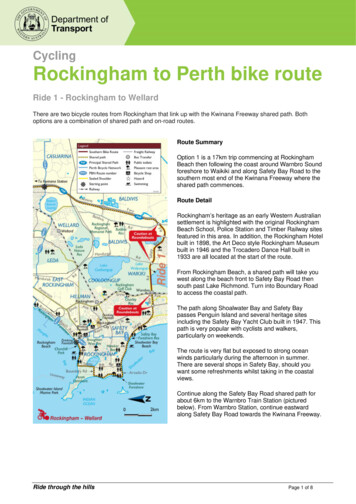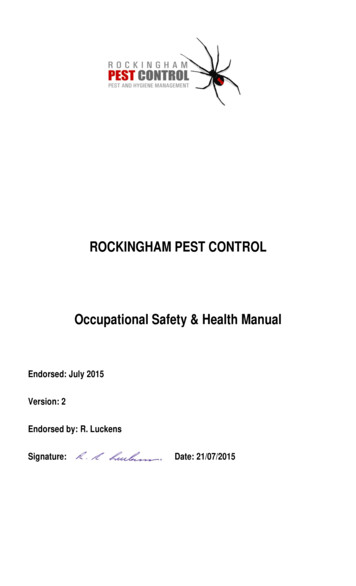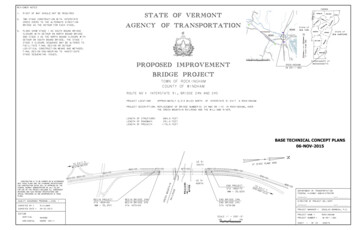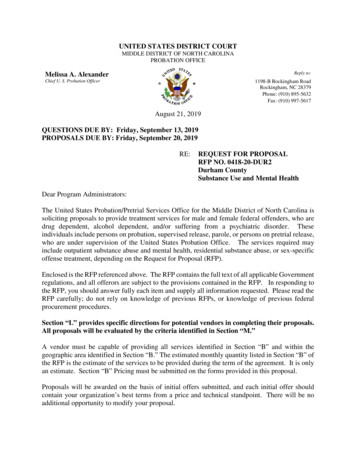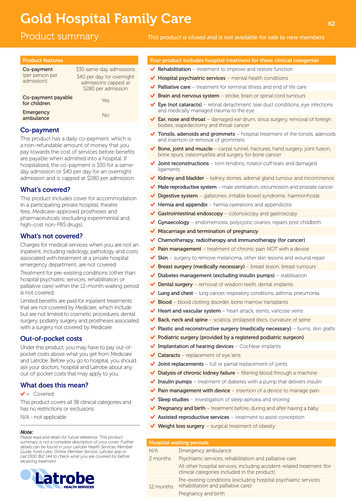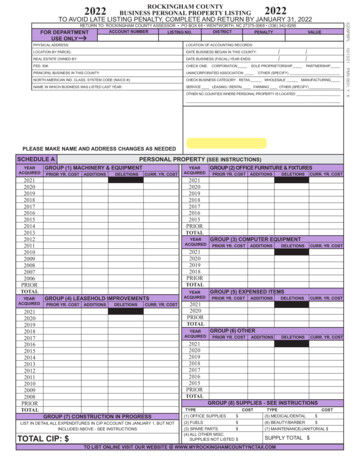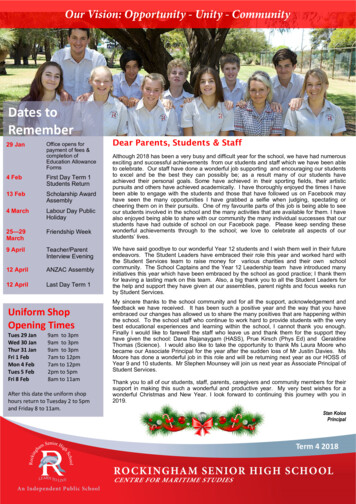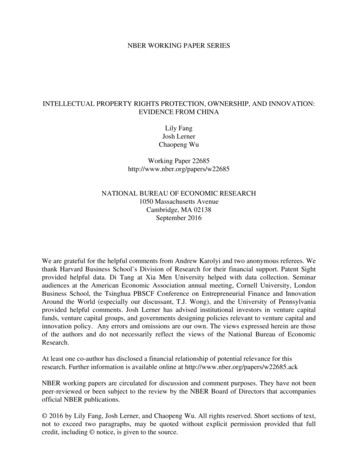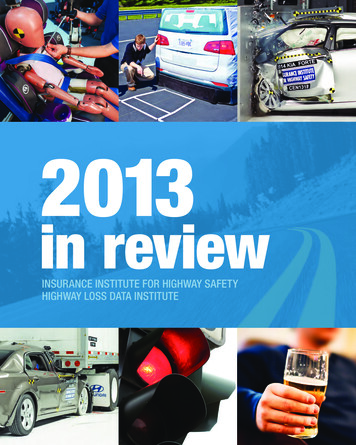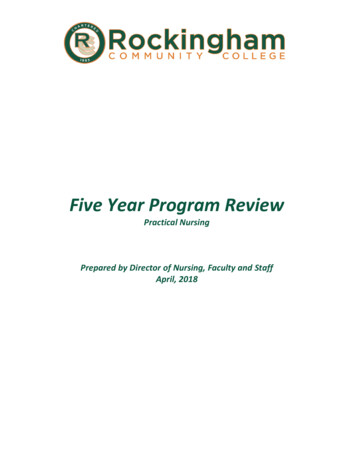
Transcription
Five Year Program ReviewPractical NursingPrepared by Director of Nursing, Faculty and StaffApril, 2018
TABLE OF CONTENTSFive Year Program Review – Practical NursingA. Program Purpose . 3B. PN Student Learning Outcomes. 4C. Program Resources . 61.2.3.4.Staffing. 13Facilities and Equipment. 14Budget . 15Program Specific Professional Development . 15D. Student Data . 18E. Program Course Capacity and Fill Rates . 19F. Curriculum . 19G. Advisory Committee . 21H. External Accreditation . 24I. Passing Rates and Narrative on Licensure/Certification Exam . 27J. Marketing . 27K. Program Strengths, Weaknesses, Opportunities, and Threats . 29L. Recommendations and Action Plan to Improve the Program . 30Appendices:Appendix A: PN Student Achievement Outcome Data . 33Appendix B: Advisory Committee Meeting Minutes . 34Appendix C: Glossary . 54Practical Nursing1
Program: Practical NursingPrepared by: Director of Nursing, Faculty, and StaffDate: April, 2018A. Program Purpose/ Mission and PhilosophyProgram Purpose:Nursing education at the practical nursing level is a process that facilitates changes in behaviorand the acquisition of knowledge, skills, and attitudes necessary to function in the entry-levelrole of the licensed practical nurse (LPN). The Practical Nursing (PN) curriculum is conceptuallybased and founded on principles of adult and collaborative learning. The North Carolina Boardof Nursing governs the role of the LPN.Graduates of this program are eligible to apply to take the National Council LicensureExamination (NCLEX-PN). Employment opportunities include hospitals, rehabilitation/longterm care/home health facilities, clinics, and physicians’ offices.Mission:The PN Program supports the mission of the North Carolina Community College System and themission of Rockingham Community College. The PN program’s mission is to “foster anenvironment of scholarly excellence that prepares diverse student populations to be nursingcaregivers that are compassionate, self-motivated critical thinkers who will improve the healthand wellness of local, national, and global communities.” Within this mission, the goal ofnursing faculty is to promote the highest quality of nursing care to the individual, families, andsignificant persons, as well as the community. The aim is to facilitate optimum health, quality of life,and achievement of potential for the individual.Philosophy:The Nursing faculty is committed to promoting the development of qualified life-long learnersprepared for the professional role of the licensed practical nurse at the entry level. Thephilosophy of the Practical Nursing Program is derived from the faculty’s beliefs regarding theindividual, environment, health, nursing, practice, and education of the Practical Nurse. Thegraduate of the PN program at Rockingham Community College is prepared to meet theeducational competencies defined by the National League for Nursing (NLN) and the NursingPractice Act, State of North Carolina. The practice of nursing is directed toward meetingthe health care needs of individuals throughout their lifespan. The PN prepared nurse role ischaracterized by evidence-based clinical practice with the provision of care for individuals andfamilies in structured settings under the supervision of the registered nurse, medical provider, orother authorized providers (NC Board of Nursing, 2018).Practical Nursing3
B. Program Student Learning Outcomes1. Provide the current and past year Program Student Learning Outcomes and theresults with how the faculty within this program used the results for improvement.2016 – 2017:SLO 1: Client NeedsPN students will reflect Client Needs across the life span in a variety of settings to include theeight subcategories of: 1) Coordinated Care, 2) Safety and Infection Control, 3) HealthPromotion and Maintenance, 4) Psychosocial Integrity, 5) Basic Care and Comfort, 6)Pharmacological Therapies, 7) Reduction of Risk Potential, and 8) Physiological Adaptation.Results: July 2017Two categories of "Client Needs" exceeded the 65% benchmark (PN graduates, summer2016).NCLEX Pass Rate for 2016 (7 graduates) 100%PN faculty reviewed the Client Needs category and implemented changes in the nursingcurriculum as needed. The PN program utilized the “SAFE Center” for study skills,critical thinking, and clinical reasoning.SLO 2: Nursing ProcessPN students will use the Nursing Process to organize and deliver nursing care to clients andgroups to include the four major categories of: 1) Data Collection, 2) Planning, 3)Implementation, and 4) Evaluation.Results: July 2017None of the categories of "Nursing Process" exceeded the 65% benchmark (PNgraduates, spring 2016) although 63% was achieved in the “Implementation” category.NCLEX Pass Rate for 2016 (7 graduates) 100%PN faculty reviewed the Nursing Process category and implemented changes in thenursing curriculum as needed. The “Data Collection” category was emphasized in theclinical setting with the implementation of a care map demonstrating understanding of thenursing process.Practical Nursing4
SLO 3: Human FunctioningPN students will reflect the categories of Human Functioning as a framework that focuses onthe client's ability to maintain essential life functions as follows: 1) Protective Functions,2) Nutrition, 3) Growth and Development, 4) Psychosocial-Cultural Functions.Results: July 2017None of the categories of "Human Functioning" exceeded the 65% (PN graduates, spring2016). Two categories reached the 60-63 % range for Human Functioning.NCLEX Pass Rate for 2016 (7 graduates) 100%PN faculty reviewed the Human Functioning category and implemented changes in thenursing curriculum as needed. Students were referred to the “SAFE Center” for facultyguided remediation to increase their knowledge and skills in the area of HumanFunctioning.SLO 4: Health AlterationsPN students will utilize a framework of care to employ the categories of Health Alterations thatimpact the care of clients across the wellness continuum as follows: 1) Cardiovascular,2) Endocrine/Metabolic, 3) Gastrointestinal, 4) Reproductive, 5) Integumentary/Musculoskeletal, 6) Immune, 7) Nervous/Sensory, 8) Renal/Urinary, 9) Respiratory.Results: July 2017None of the categories of "Health Alterations" exceeded the 65% benchmark (PNgraduates, spring 2016). One category achieved 63 % in this content area.NCLEX Pass Rate for 2016 (Seven graduates) 100%.PN faculty reviewed the Health Alterations category and implemented changes in thenursing curriculum as needed. Clinical rotations in an acute care facility were designedto promote student learning in the area of Health Alterations.Practical Nursing5
2017 – 2018:SLO 1: Client NeedsPN students utilized fundamental concepts within the domain of Client Needs to providetherapeutic care to individuals. PN students will mastered skills that include airwaymanagement/oxygenation, ambulation, medication administration, nutrition, ostomy care,personal hygiene, specimen collection, vital signs, urinary care, surgical asepsis, and wound care.Results: December 2017100% of the first semester students achieved mastery of the PN Nursing Skills followinglab practice sessions.NCLEX Pass Rate for the 2017 PN cohort (20 students) will be determined following thesummer 2018 graduation.The use of “standardized patients” for competency assessment was utilized in addition tothe “ATI Skills Modules” to enhance the students’ mastery of Client Needs.SLO 2: Nursing ProcessSecond semester PN students used the Nursing Process for clients in various stages of growthand development with emphasis on the concepts of oxygenation and perfusion.Results: May 2018The Nursing Process for clients in various stages of growth and development related tothe concepts of oxygenation and perfusion will be assessed at the end of the secondsemester, May 2018.SLO3: Human FunctioningPN students identified Human Functioning as a framework that focused on maternal/newbornage appropriate assessment for postpartum and newborn care.Results:May 2018 The Human Functioning category for maternal/newborn care will be assessed at the endof the second semester, May 2018.Practical Nursing6
SLO4: Health AlterationsPN students will use evidence-based interventions to manage diabetes as it relates to theendocrine system associated with Health Alterations. The Diabetes Learning Activityimplemented in the second semester will examine internal and external environmental factorsthat influence the health and well-being of individuals with health alterations.Results: May 2018The Human Functioning category for diabetes care will be assessed at the end of thesecond semester, May 2018.C. Program Resources1. Staffinga.Have there been changes in faculty in the past three years?One of the faculty members in the PN program was re-assigned in the summer,2016 to coordinate the certified nursing assistant (CNA) program. The nursinglab/clinical coordinator provided classroom assistance as well as lab/clinicalinstruction. Clinical rotations are based on a 1:8 or 1:10 ratio depending on thelimitations set by the healthcare facilities. At the present time, one PN adjunctfaculty member works with students in the lab/clinical setting. There issecretarial support from the Administrative Assistant, Division of Health andPublic Services.Fall 2015 – Spring 2018FULL TIMECES onFileCourses Credentialedto 2017Total for Fall 2017 FT (not individual faculty)Caroline BairdRebecca GurleyPhyllis HortonJuanita Clinical CoordinatorTotals by Full Time FacultyPART TIMEDiane BatchelorCES onFileYesCourses Credentialedto TeachNursingFTEFall201713.066.53XTotals by Part Time FacultyPractical Nursing7
b.Are there any anticipated any changes in the coming three years?There is currently one full-time faculty vacancy in the PN program that isexpected to be filled during the fall semester, 2019. The need for clinical adjunctinstructors is expected to increase with a projected increase in enrollment for thePN program.2. Facilities and Equipmenta. Provide a narrative regarding the adequacy of your facilities as well as needs.In January 2016, RCC’s Health Science Simulated Hospital was opened in the renovatedOwens Building. The nursing simulated hospital area consists of a large skills lab, 2individual patient assessment rooms, an ICU area with 2 critical care rooms and 2additional patient care rooms. Adjacent to the skills labs is a Comprehensive LearningCenter with a seating capacity of 60.The second floor of the Owens building contains five classrooms as well as a computerlab that seats 40 students. Three classrooms seat approximately 24 students each whiletwo of the classrooms have a capacity for 30 students. As nursing enrollment increases,there may be a need for additional classroom space.b. Provide a narrative regarding the adequacy of your equipment as well as needs.The nursing simulated hospital area contains three high-fidelity manikins withinterchangeable parts along with four low-fidelity manikins in poor condition. The lowfidelity manikins need to be replaced as soon as possible. Hospital beds are locatedthroughout the nursing skills lab as well as in the ICU area and additional patient carerooms. There is a birthing bed without an actual birthing manikin in one of the patientcare rooms. There is a pressing need for a birthing manikin related to the limited clinicalfacilities with OB services in Rockingham County. Additional equipment in the nursinglabs (computers, furniture) is in excellent condition as this area has been in use for lessthan three years. There is a need for a projector in the nursing skills lab to allowinstructors to present online “real life scenarios” during skills training.Classrooms in the Owens Health Sciences building are well equipped with computers,projectors, and white boards. There is an Elmo (overhead projector) available for use bythe nursing faculty. This overhead projector can be moved from one classroom toanother as needed.Future needs for the simulated hospital include “NAO,” one of the first humanoidinteractive robots that was created in 2006. NAO (pronounced “now”) has been used inhealth care for patient teaching activities. For example, NAO can be programmed toPractical Nursing8
work with diabetic children (patient teaching scenarios) as well as communication withchildren diagnosed with autism. Please see the following link for additional informationregarding NAO. o3. Budgeta. Provide the program budget for the previous and current year.b. Provide a narrative regarding future budgetary needs.A projector to be installed in the skills lab for online teaching/learning activities will berequested for 2018-2019 in addition to the four low-fidelity manikins described above.Future budgetary needs will include a birthing manikin for the nursing area of thesimulated hospital for 2019-2020.4. Specific Professional Developmenta. Provide a narrative regarding professional development.All nursing faculty have participated in the campus-wide professional developmentseminars that focused on strategies to increase student learning, motivation, retention, andacademic success. We have also had campus-wide faculty professional development forvarious new technologies. All nursing faculty received training on the RCC eLearningplatform (Moodle) and the development of online classes. Nursing professionaldevelopment included facility specific activities to keep abreast of any policy andPractical Nursing9
procedure revisions. Nursing faculty receive continuous clinical updates to enhance theeffectiveness of hospital preceptors. There are educational sessions to prepare the facilityclinical preceptors to assist the nursing students to prepare them for transition to practice.All nursing faculty must complete the American Heart Healthcare Provider CPR renewaltraining every 2 years. Two PN faculty members attended seminars to prepare for theSociety for Simulation in Healthcare (SSH) Certified Healthcare Simulation Educator(CHSE) exam. The PN lead instructor is presently enrolled at Duke University tocomplete a Master’s in Nursing Education degree. The director of nursing programsholds a Doctorate in Nursing Practice with a major in Advanced Leadership inHealthcare. Nursing faculty (PN and ADN) attend the North Carolina Board of NursingAnnual Education Summit that is presented in April of each year. Additional national andstate conferences for the PN faculty include the ATI National Nurse Educator Summit(national), the Triad Consortium of Clinical Education Practice (TCCEP) conference, theNorth Carolina Community College System (NCCCS) conferences, and the NorthCarolina Council of Practical Nurse Educators (NCCPNE).The ATI Academy is a comprehensive lineup of webinars designed to help faculty expandtheir knowledge as nurse educators. All nursing faculty received an ATI AcademyPremium Membership with the products provided for nursing students. Professionaldevelopment activities completed through the ATI Academy have included topics such as“A Green Approach to Successful Student Remediation,” “Developing a Concept-BasedCurriculum that Meets the Needs of Our Next Generation of Nursing,” “Using ActiveLearning Strategies in the Classroom,” “TEAS V Background and Research,” and“Innovative Teaching Tools in the Nursing Education Classroom: Unfolding CaseStudies.” The nursing department archives all ATI Academy presentation evaluationswith documented objectives and faculty responses regarding the effectiveness of thewebinars. In addition to the Academy, ATI provides two complimentary registrations tothe yearly national Educational Summit. On-site training seminars provided by the ATIEducation Consultants have included topics such as “Active Learning,” “Real LifeScenarios,” “ATI Custom Reporting,” “Curriculum Management and ArticulationProgram (C-MAP),” and the “Comprehensive Assessment & Review Program(CARP).”Professional memberships for nursing faculty include the American Nurses Association(ANA), North Carolina Nurses Association (NCNA), North Carolina Associate DegreeNursing Council (NCADN), Sigma Theta Tau (International Honor Society of Nursing),National League for Nursing (NLN), and the National Association of Orthopedic Nursing(NAON).Practical Nursing10
bProvide a narrative regarding future professional development needs.Simulation training is a bridge between classroom learning and real-life clinicalexperiences. According to the NC Board of Nursing (NCBON) “it is the responsibility ofthe Program Director to ensure that the International Nursing Association for ClinicalSimulation and Learning (INACSL) Standards of Best Practices are utilized for leadfaculty and lab personnel in simulation education” (NCBON, Simulation Guidance,2018). The NCBON Education Rule 21 NCAC 36.0321 states “Programs not holdingnational nursing accreditation shall limit simulation experiences to no more than 25percent in any course including the focused client care experience.” This rule includesthe nursing education program shall: (1) demonstrate that simulation faculty have beenformally educated, and maintain the competencies in simulation and debriefing; and (2)provide a simulation environment with adequate faculty, space, equipment, and suppliesthat simulate realistic clinical experiences to meet the curriculum and course objectives.”With the continuation of the ATI Academy resources, professional workshops outlinedabove, and personal educational endeavors, support for simulation education is theprimary nursing faculty need. While the Owens Simulated Hospital provides a superiorenvironment for student learning, the faculty need for additional simulation training andcertification supersedes additional professional development at this time. The PN leadinstructor plans to complete the required national certification (CHSE) exam prior to thefall semester, 2018.Practical Nursing11
D. Student Data1. Program Unduplicated Headcount Enrollment:Program - Practical NursingPractical NursingPre-Practical 22FA13162. Number of Graduates:Graduates - Practical NursingPractical Nursing3. Student Demographics:Age Range 1818-1920-2223-2930-3940-4950 EthnicityBlack, Non-HispanicHispanicOther/Unknown/MultipleWhite, Non-HispanicGenderFemaleMaleHome CountyRockinghamOtherCredit HoursFull-timePart-timePractical 131920FA13122712
E. Current Program Course Capacity and Fill RatesEnrolled22Capacity % Capacity3562.9%Sec NameNUR-101-0001Sec Short TitleSec TermPractical Nursing I 2017FAF. Curriculum1. Refer to the Annual Program of Study Review to provide a narrative describing anychanges or revisions that have been made since the last review.MAT 110 Mathematical Measurement was removed as a prerequisite from the programof study in fall 2015, due to changes in the course content. The course was no longerappropriate or specific to nursing. Mathematical content is now implemented in the firstcourse of the PN program (NUR 101 Practical Nursing I) and reinforced in followingcourses throughout the curriculum.Effective fall 2014, the Practical Nursing Program transitioned to a Concept-BasedCurriculum for nursing education as mandated by the North Carolina CommunityCollege System (NCCCS) in collaboration with the NC Board of Nursing. This transitionoccurred one year prior to the mandated date.The nursing programs (ADN and PN) collaborated with ATI Nursing Education, fall2014, as part of the Improvement Plan submitted to the NC Board of Nursing for lowNCLEX scores. The nation's leading e-Learning provider, ATI offers products andresources that are influential in improving faculty, student, and program outcomes. Nurseeducators have the power to augment curriculum, revamp courses and facultydevelopment, and improve student outcomes and lower attrition rates. NCLEX scoresshowed significant improvement following the implementation of the ATI resources andcontinue to improve annually.Fall 2014, established The Student Achievement For Excellence (SAFE) Center, which isfaculty-guided remediation sessions offered to enhance student learning for specificnursing courses. Each faculty member schedules SAFE Center hours to allow forreinforcement of concepts learned in the classroom.Effective fall 2015, BIO 163 and PSY 110 were removed as prerequisites/corequisitesfrom the Practical Nursing Program due to the need for college transfer courses. Theywere replaced with BIO 168, BIO 169, CHM 130 or 131, and PSY 150. Whileconsidering this curriculum change, a review of pertinent literature located a researcharticle in The Journal of Nursing Education by Seago, Keane, Chen, Spetz, & Grumbach(2012), which found a student’s pre-nursing and science GPA was a positive predictor forsuccess. Given this information, the decision was made to replace BIO 163 and PSY 110Practical Nursing13
with the higher-level Biology and Psychology courses in addition to the Chemistry.Some of the entities hiring RCC Practical Nursing graduates began mandatingeducational progression. These higher-level courses are also pre-requisites for theAssociate Nursing Degree program enabling Practical Nursing graduates to transfer theminto an ADN program and subsequent BSN program, should they decide to further theireducation.Effective fall of 2015 the grading scale was changed from a traditional 7- point gradingscale to a 10- point scale, per student feedback. Progression in the program required atleast an 80% or a “C.” The change to the 10-point scale aligned with other institutions ofhigher education in our area. Progression in the program continues to require an 80% andthe student receives a “B”. Some of the facilities hiring the practical nurse graduates lookat GPAs. The change to the 10-point scale makes them more competitive in themarketplace.Fall 2016, the nursing faculty and students moved to the Simulated Hospital located inthe Owens Health Sciences building. This move increased the use of existing and newsimulation equipment to supplement class, lab, and clinical activities. It is anticipatedthat the nursing Simulated Hospital area will increase in use as faculty meets theeducational requirements for training and expertise specified by the NCBON (see abovefuture professional development needs).Fall 2017, removal of the 7-year requirement for BIO and CHM courses eliminated abarrier that prevents some students from applying for the program without repeatingclasses.PN textbooks changed from Lippincott basic nursing texts to Pearson comprehensivetexts in fall 2015. This was in response to changes in the program to a conceptual modelof teaching. After one year, in fall 2016, textbooks changed to Davis Publishing“Understanding Medical-Surgical Nursing.” This textbook presented the material ineasily understood language and focused on the role of the practical nurse. It did not relatewell to nursing concepts and the textbooks changed fall 2017 to a medical-surgicalnursing text that focused on medical conditions and care of the clients.Effective fall 2018, deleted CHM 130 as a prerequisite for the nursing programs.Rationale - the RCC Science Department will no longer be offering CHM 130/130AGeneral, Organic, and Biochemistry. The two introductory level Chemistry courses forRCC nursing programs will be CHM 131/131A, Introduction the Chemistry Theory andLab, and CHM 151, General Chemistry I. Specific universities require chemistry to be131 or higher for transfer credit.2. Provide a narrative to describe any changes in curriculum that are anticipated inthe next few years.Practical Nursing14
There are no classroom curriculum changes anticipated in the next few years. There willbe an increase in “simulated clinical activities” with the addition of a Certified HealthcareSimulation Educator (CHSE). Current nursing faculty discussions have included raisingthe GPA requirements for entrance into the PN program from 2.0 to 2.5. Rationale is toadmit students who are more likely to be successful in nursing.G. Advisory Committee (PN and ADN Combined)1. List Advisory Committee members.Healthcare and Facility Advisory Committee MembersMr. Chris Golding, Greensboro Area Health Education (AHEC)Ms. Lisa Guy, Education Coordinator, Cone Health SystemMs. Lavern DeLaney, CNO & VP Patient Care Services, Alamance Regional MedicalCenterMs. Mona Easter, CNO and VP, Annie Penn HospitalMs. Wendy Franks, DON, Penn Nursing CenterMs. DeGloriaous Garner, DON, Avante @ ReidsvilleMs. Connie Lewter, Faculty Consultant, Cone Health SystemMs. Waqiah Ellis, DON Cone Health SystemMs. Virginia Rich, Danville Regional Medical CenterMs. Lynn Flanagan, Executive Director, Hospice of Rockingham CountyMs. Ashley Cooper, Director, LEAF CenterMs. Marilyn Thompson, LEAF CenterMs. Nicky Edwards, Morehead High SchoolMs. Wanda Foster, UNC Healthcare RockinghamMs. Tammy Thompson, DON, UNC Rockingham Rehabilitation / Nursing CareMs. Vivian Moore, Reidsville Senior High SchoolJennifer Love, Clinical Supervisor, Rockingham County Public HealthMs. Teresa Harris, Rockingham County High SchoolMs. Nedine Rowe, Rockingham County High SchoolPam Meadows, Southern Virginia Mental Health InstituteStudent RepresentativesKaren Santos, RN – ADN Graduate RepresentativeRoyce Barham – ADN Student RepresentativeMekides Nida – PN Student RepresentativeRCC RepresentativesDr. Mark Kinlaw, RCC PresidentMs. Sheila Regan, RCC Vice President for Academic AffairsGretchen Parrish. RCC Vice President for Institutional EffectivenessDerick Satterfield, RCC Admissions DirectorPractical Nursing15
Laura Jennings, RCC Admissions SpecialistPeter Allen, RCC Science Faculty2. Provide copies of Advisory Committee minutes.See Appendix A3. What recommendations have the Advisory Committee made?November 20, 2013Vice President for Academic Affairs, Dr. Jan Overman opened the meeting with welcomeand brief remarks about the renovation project in the Owens Building that will house theNursing Department as well as a state of the art Lab and Simulation Hospital. Dr. PhyllisHorton, Department Chair and Director of the Nursing Programs then introduced facultyand staff. Advisory Committee members then introduced themselves. Tiffany Morris,Dean of Health and Public Safety spoke to the committee about some reorganization thatRCC has undergone adding some new areas to her division. Members of the NursingFaculty then provided nursing department updates. Time was spent asking members forideas and suggestions on improving the program. Ms. Lewter raised the testing issuerelated to alternate format questions, as they are now a part of the NCLEX. She asked ifwe as faculty are including these types of questions on our tests as well. Faculty willcontinue to have these types of questions included. The department has a consultantcoming in to examine test questions faculty have written as well. Members from ConeHealth talked about Preceptors needed and suggested ADN students have somealternative preceptorships out in the community versus the hospitals as the trend is forADN nurses to work in home health.November 11, 2014After a brief welcome by Suzanne Rohrbaugh, Vice President for Academic Affairs,introductions of faculty, staff and committee members were presented. Dr. Kim Clark,Dean of Health and Public Safety then shared remarks about the ongoing constructionproject as well as her open door for sharing ideas and concerns. Faculty provided nursingdepartment updates. There was much discussion on changes the department hasimplemented to increase student success. The addition of the pharmacology course andour partnership with ATI were discussed, as well as an increase in simulation labs for ourstudents. The nursing department introduced the idea of an LPN to ADN program thatmay be occurring in the future. Time for Board input and suggestions brought forthdiscussion that there are more outpatient areas at Cone Health and that these areas willlook to hire both RNs and LPNs,
individual, environment, health, nursing, practice, and education of the Practical Nurse. The graduate of the PN program at Rockingham Community College is prepared to meet the educational competencies defined by the National League for Nursing (NLN) and the Nursing Practice Act, State of North Carolina. The practice of nursing is directed .
